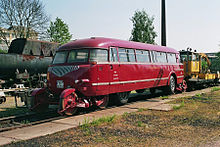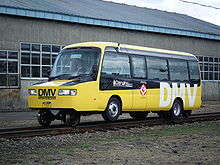Rail-road omnibus
The rail-road omnibus , also known as Schi-Stra-Bus for short , is a two-way vehicle for passenger transport on railways and roads. The German Federal Railroad (DB) used it both as a local train and as a rail bus .
The vehicle
The vehicle is a special omnibus with all the facilities necessary for road traffic . The rail-road bus was equipped with a diesel engine from Klöckner-Humboldt-Deutz from the bus industry. This had an output of 88 kilowatts (120 hp), it enabled a speed of 80 km / h on the road and 120 km / h on rails. The vehicles offered 43 seats and 15 to 24 standing places.
The car was a one-way vehicle , but was equipped according to the regulations for rail traffic. It had doors on both sides, a brake that was suitable for railways , which acted on the track wagons, a safety driving circuit and an emergency braking device . For operation on railroad tracks , the bus was placed on two two-axle underframes - called “track wagons”. For this purpose, the rail-road bus had two hydraulic lifting devices, with which the front and rear half of the vehicle were alternately lifted for mounting and removing from the track wagons. In front of the front axle and behind the rear axle there was a bearing for the pivot of the track wagon. A grooved rail track at street level was required for the repositioning. In rail operation, the front axle was completely lifted, the tires of the rear wheels sat on the rails and provided the drive. The passengers stayed on the bus while switching to and from the track wagons.
procurement
In 1951, the Deutsche Bundesbahn ordered two prototypes from the company Nordwestdeutscher Fahrzeugbau in Wilhelmshaven . The track wagons were manufactured by Waggon- und Maschinenbau GmbH Donauwörth . The prototypes were delivered and tested in 1952. Shortly thereafter, three series vehicles followed, one of which was presented in March 1953 at the International Motor Show in Frankfurt am Main . In 1953 another 50 vehicles were ordered. In total, however, only 15 cars were used on the rails, the rest of them operated as pure road vehicles.
commitment
Passau – Wegscheid
Test drives took place in 1951 on the Passau – Wegscheid railway line , which also included two rack sections . The rail-road omnibus also managed these steep stretches. Due to the snow conditions in winter, year-round operation seemed impossible here.
Passau – Cham
The first three series vehicles were used on the route from Passau to Cham from June 12, 1953, when the summer timetable began :
- Passau– Grafenau : street
- Grafenau– Bodenmais : 46.0 km of rail on the Grafenau – Zwiesel and Zwiesel – Bodenmais railway lines
- Bodenmais– Kötzting : Street
- Kötzting – Cham: 17.8 km of rail on the Cham – Lam railway line
Of the total distance of 140.7 km, 63.8 were covered on rails. Ten minutes were allotted for moving from rail to road and vice versa. In addition, the direction of travel was changed at Zwiesel station . The total travel time was five and a half hours. The connection was offered once a day. Because there was no shelter in Cham, the connection was later extended by 19.2 km to Furth im Wald using the Schwandorf – Furth im Wald railway line . This required another change of direction in Cham.
The connection in the Bavarian Forest existed until June 1, 1957 and was given up mainly because of the traction problems that occurred in winter. Only one of the connections to the Rail Road Omnibus she received under the number 426h own schedule table in the timetable of the German Railways and was therefore in the enclosed card with a special signature located.
Augsburg – Füssen
From 1954 to 1958 the Augsburg - Füssen connection was served once a day . It ran from Augsburg on the road to Pforzen , then on the track over the Allgäubahn , the Biessenhofen – Füssen railway line and the Marktoberdorf – Lechbruck railway line to Roßhaupten . From there it was back on the road to Füssen. In the course book it was listed under the number 406c. The journey took three hours and ten minutes.
Koblenz – Betzdorf
The connection between Koblenz and Betzdorf was established for the winter timetable 1954/55 . The route led from Koblenz on the road to Dierdorf and from there over the Engers – Au railway to Au (Sieg) and further on the Sieg route to Betzdorf. It turned out to be the greatest success of this concept and therefore lasted the longest. The number of seats available was often insufficient for the number of people willing to travel. The journey took two and a half hours. This was the only connection on which two trips per day and direction were offered. The last scheduled trip on May 27, 1967 marked the end of the rail-road bus.
Wutach Valley Railway
The Wutach Valley Railway was built for strategic military reasons. The middle section between Weizen and Blumberg overcame, due to inclines, a distance of 9.6 km as the crow flies with a railway line of 24.7 km in length. As expected during construction, the operating result was very negative, as the ticket prices were based on the length of the route and not on the linear distance. The traffic on the street was faster and cheaper. In the post-war period, when the strategic military importance of the line ceased to exist, rail traffic was discontinued in the central section in 1955, but the further sections in the north and south continued to be served by rail, which meant two changes at the Weizen station and at the Blumberg-Zollhaus station . The aim was to spare passengers these changes, which is why the Deutsche Bundesbahn used the Schi-Stra-Bus on the parallel federal highway 314 . However, the experience with the road-rail vehicle was so bad that its use ended with the timetable change in December 1955.
Further missions
There were other, each only short assignments, for example from Bernkastel to Remagen , via the Black Forest Railway (Baden) to Immendingen or between May 1953 and November 1955 from Waldshut via the Hochrheinbahn .
Preserved vehicle
A vehicle with two track wagons is owned by the Bochum Railway Museum Foundation and is on display in their Railway Museum. This vehicle is operational. However, the approval of the Federal Railway Authority restricts its use today: Passages through tunnels and oncoming traffic on multi-track routes are not permitted. Moving between road and rail is occasionally demonstrated at larger events.
Others
When the computer-readable vehicle numbers were introduced on January 1, 1968, the series number 790 was still assigned to the rail-road bus, but all vehicles had already been taken out of service by the deadline.
Similar vehicles on other railways
France
In the early 1940s, the engineer Talon developed a system in which a normal street bus ran on rails and could pull a light railcar sidecar of the standard " Decauville " type. The bus drove over a special ramp onto two track wagons, after which the front wheels no longer touched the rails, but the inner of the rear double wheels kept contact with the track. At least one of these vehicles powered by wood gas was used in the summer of 1943 on the 54 km long railway line of the Compagnie Carcassonnaise de Transports en Commun (CCTC) from Carcassonne to Quillan .
Japan
In Japan, too, road-rail buses were developed under the name “DMV”. The DMV920 model no longer needs an external bogie, the two axles that are carried along are only lowered during the single-bar.
United States
Such a system was experimented with in the United States in the second half of the 1960s. Two Red Arrow Lines diesel buses were converted so that they could also run on rails.
See also
literature
in alphabetical order by authors / editors
- Siegfried Bufe: Roads to Passau . In: Eisenbahn Geschichte 93 (2019), pp. 12–27.
- Gustav Nagel: On rubber and steel . In: Lok Magazin. Volume 41, No. 250 7 / (2002). ISSN 0458-1822, pp. 52-53.
- Wolfgang Stoffels: The rail-road omnibuses . German Society for Railway History, Part 25 (1980). ISBN 3-921700-31-0 .
- Klaus Strack: 150 years of the railway in the Siegtal . Nümbrecht 2010. ISBN 978-3-89909-100-7 .
Web links
- The rail-road bus at www.westerwaelder-bahnen.net
- The rail-road bus between Betzdorf and Koblenz (1958)
- L'étonnant autorail-bus de l'Aude (French) with photo of the Talon bus
Remarks
- ↑ So: Bufe, p. 27. Since the vehicles were not delivered until 1952, it must probably be "1952".
- ^ So: Official course book of the Deutsche Bundesbahn from the summer of 1955; Bufe, p. 27, names 142.7 km.
Individual evidence
- ↑ Nagel.
- ↑ Bufe, p. 27.
- ↑ Bufe, p. 27.
- ↑ Operations in the Westerwald and in other areas
- ↑ Bufe, p. 27.
- ↑ a b Information according to the official course book of the Deutsche Bundesbahn from summer 1955.
- ↑ On this connection in particular: Strack, pp. 200f.
- ↑ Nagel.
- ↑ Schi-Stra-Bus in use on the Wutachtalbahn .
- ^ Tomas Meyer-Eppler: The Schie-Stra-Bus is running again . In: Lok Magazin 3/2002, p. 22.
- ↑ L'étonnant autorail-bus de l'Aude at grandsudinsolite.fr, accessed on January 6, 2018
- ↑ Clive Lamming: Trains de Légende: Les Réseaux français et la Naissance de la SNCF (1938–1950) . 2006, ISBN 2-8302-2147-8 , pp. 105 .
- ↑ Finally the "DMV era" begins.
- ↑ The Trolley Dodger at thetrolleydodger.com, accessed May 6, 2020




